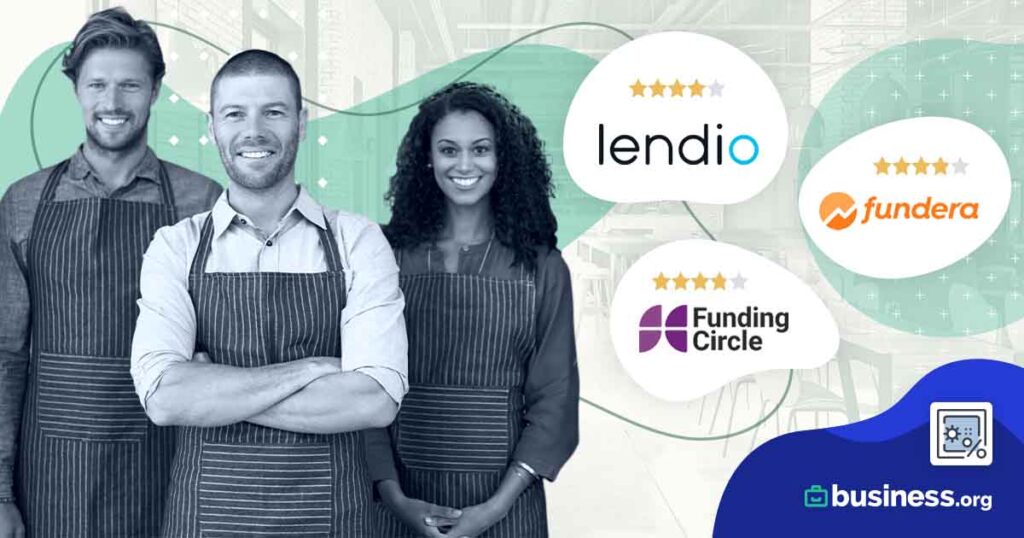We are committed to sharing unbiased reviews. Some of the links on our site are from our partners who compensate us. Read our editorial guidelines and advertising disclosure.
What is an SBA Loan? SBA Financing Options 101
Interested in SBA financing―loans backed by the US Small Business Administration―for your business? It makes sense. As you’ve likely heard, SBA loans can get you low interest rates and long loan terms, making them an affordable financing option for business owners.
But as with any term loan, there’s more you need to know about SBA loans―like the details of how they work, how much it will cost you, and how you actually get one.
That’s where we come in. We’ll explain what the SBA loan program is, what kinds of SBA loans you can get, and how you can apply for them.
What is an SBA loan?
SBA loans refer to any small-business loans backed by the US Small Business Administration (or SBA) as part of one of several SBA loan programs.
But let’s break that down a bit.
Lots of business owners have a hard time getting financing for their companies. In large part, that’s because lenders want to lower their risk, so they only offer financing to the most qualified business owners.
The SBA loan program tries to address this problem. With an SBA loan, the US Small Business Administration backs, or guarantees, a portion of the loan―meaning they basically promise the lender that no matter what happens, they won’t lose tons of money on the loan.
That makes SBA lending less risky for lenders, which means they’re more willing to offer loans to business owners that they would otherwise turn down.
To be clear, the SBA does not extend its own loans (except for some specific exceptions we’ll discuss later). It simply backs loans made by business lenders. So you’re still getting a loan through a normal lender―the SBA just mediates the deal a bit.
And those business owners don’t just get any old loan either. Because each SBA loan program comes with a specific set of rules for lenders―rules that set maximum fees and interest rates, for example―SBA borrowers get loans that have competitive rates, long repayment terms, and versatile uses.
In many cases, that makes an SBA loan one of the best deals you can get on business financing.
SBA loans do have some downsides though.
For example, as with most government-related things, the SBA loan program has lots of rules, requirements, and regulations. That means the applications need plenty of documentation and detail. It can take a long time to get your loan application ready in the first place―and then you still have to wait for lender and SBA approval. In other words, SBA loans can take some time (weeks or months) to get.
And while the Small Business Adminstration’s loan program does make financing more accessible for more business owners, SBA loans still have fairly restrictive borrower requirements. Most SBA lenders require at least the following:
- A business that’s at least two years old
- A personal credit score in the high 600s (likely 680 or above)
- Plenty of business revenue (more than $100,000) to cover loan costs
Oh, and you have to show that you can’t get financing elsewhere―meaning you’ll need to have a loan rejection or two in your pocket.
Anyway, those borrower requirements mean that business owners with a low credit score, for example, won’t qualify for SBA loans. Neither will young startups. (But don’t worry, there are plenty of bad credit startup loans available.)
Still, if you think you can qualify and you’ve got some patience, an SBA loan could offer just the low-cost working capital you want.
By signing up I agree to the Terms of Use.
Types of SBA financing
Think SBA loans sound interesting so far? Then let’s talk about which specific loan program is right for your business.
See, there are several types of SBA business loans. And as we mentioned earlier, each loan program comes with specific rules. You’ll want to find the loan program that best matches your business’s needs.
So let’s talk about some of the most popular loan programs the SBA has to offer.
What is an SBA 7(a) loan?
Many people use “SBA loans” to refer to SBA 7(a) loans.
That’s because these are some of the most versatile SBA loans you can get.
You can use SBA 7(a) loan proceeds to cover all sorts of business expenses, from working capital needs to real estate acquisition to debt refinancing.
Your specific loan amount, repayment term, and interest rate will depend on how you plan to use your loan money. But don’t worry, they’re all good. The interest rate on SBA 7(a) loans, for example, gets tied to the prime rate, so you’ll always end up with a competitive rate.
One other thing to note: the SBA 7(a) loan program actually has several sub-programs. So while you can get a generic SBA 7(a) loan, you can also get one of these more specific financing options:
- SBA Express loan (loans with a guaranteed fast application turnaround time)
- SBA Export loan (loans for businesses that export goods to foreign markets)
- SBA CAPLines line of credit (lines of credit for seasonal or short-term needs)
Like we said, versatile. Plus, SBA 7(a) loans are pretty widely available. Most big banks (and plenty of smaller ones) offer SBA 7(a) loans as part of their financing options.
So for many businesses, SBA 7(a) loans offer the best SBA loan program.
What is an SBA 504 loan?
SBA 504 loans―also called CDC/SBA 504 loans―work a little differently than SBA 7(a) loans.
For starters, SBA 504 loans have to be used strictly for real estate or equipment purchases (as opposed to general working capital or debt refinancing). And when you use your SBA 504 loan for one of those purposes, it needs to lead to business growth and new jobs.
SBA 504 lending also works differently. While 7(a) loans come from a business lender, an SBA 504 loan comes from two sources: First is a Certified Development Company (CDC), or a nonprofit company that works toward economic development in a local community. And second, a bank (or other lender). You’ll get 40% of your loan from your CDC, 50% from your lender, and the remaining 10% is up to you.
But SBA 504 loans have one big advantage: low interest rates. The interest rate on SBA 504 loans is tied to the 5- to 10-year Treasury rate, and it often ends up giving you a rate under 5%―lower than most 7(a) loans.
So if you’ve got big real estate or equipment needs, an SBA 504 loan may offer just what you need.
What is an SBA Microloan?
SBA Microloans are the last major SBA loan option.
As the name suggests, SBA Microloans are meant for smaller financing needs. They go up to just $50,000 at most―way, way smaller than 7(a) and 504 loans. As a result of this smaller size, Microloans usually come with a higher interest rate, often between 8% and 13%. They also have shorter repayment terms than 7(a) or 504 loans.
You can use your smaller loan for all kinds of working capital needs, like buying inventory, repairing equipment, adding new furniture, and stuff like that. But no, you can’t use your Microloan for refinancing or real estate.
Note that you have to find an SBA-approved microlender―not just any old lender. You can start your search at your local SBA District Office.
While SBA Microloans may not be the most versatile option, they still offer cheap working capital for businesses that can get by with smaller loans.
Other SBA loans
The three programs above are the most common SBA loan programs, but there are a couple others we should mention.
First up, the SBA offers disaster loans to businesses that have been affected by, well, disasters. For example, businesses affected by hurricanes may qualify for a Business Physical Disaster Loan, while businesses affected by COVID-19 may qualify for an Economic Injury Disaster loan. These loans come with very, very low interest rates and few borrower requirements.
To get an SBA disaster loan, your business must be in a declared disaster area. If it is, you can apply directly with the SBA (rather than through a lender as with most SBA loans).
Second, the SBA recently offered PPP loans, or loans authorized by the Paycheck Protection Program. PPP loans were designed to help businesses affected by the Coronavirus pandemic. They came with dirt-cheap interest rates―and the loans were forgivable.
As of March 31 2021, the PPP loan program has ended. Prior to that, however, businesses could apply with SBA-approved lenders to get a PPP loan.
SBA loan requirements and application
Found a loan program you’re interested in? Then let’s walk through how you can actually get your SBA business loan.
1. Check your eligibility
Before you start working on a loan application, you’ll want to make sure you qualify for SBA financing.
We suggest you start with the SBA website. Each loan program lists specific requirements. For example, to get an SBA 7(a) loan, you need to have a for-profit business, while certain non-profit businesses can get an SBA Microloan.
After you’ve checked out those basic requirements, you may want to talk to a lender or two about their specific borrower requirements. You don’t need to commit to a lender at this point―but chatting with lenders can help you make sure you have a shot at the loan you want.
And remember, most lenders look for a few specific things:
- Two years or more in business
- A credit score in the high 600s or above
- Plenty of business revenue and cash flow
But again, specific requirements will vary depending on your loan program and your lender.
2. Get your documentation together
If you think you’ve got what it takes to get an SBA loan, then you can start getting your loan application together―starting with documentation.
For the most part, this means gathering typical business loan application materials:
- Business tax returns
- Personal tax returns
- Profit and loss statement
- Balance sheet
- Debt schedule
Once you’ve found a lender, you should get a more comprehensive list. But having your basic documents together at this point can really speed up your application process later.
3. Choose an SBA lender
Next, you can choose a lender to apply with.
As we showed you above, the type of lender you apply with will depend on your loan program. For SBA 7(a) loans, for example, you can apply for all sorts of business lenders. But if you want an SBA 504 loan, you’ll need a bank and a Certified Development Company.
Since SBA 7(a) loans are the most popular, let’s dive deeper into those for a moment.
Big banks like Wells Fargo do lots of SBA lending, so they can be a good lender option. But you don’t have to go with a traditional financial institution. Online lenders and marketplaces, like SmartBiz, can also help you get your loan. It mostly comes down to your preferences.
One thing you might want to consider, though? Choosing a preferred SBA lender. See, some lenders have special arrangements with the SBA (usually because they process so many SBA loans). If you choose a preferred lender, your loan application may not have to get approved by the SBA itself―just your lender―which can speed up your loan approval time.
Ultimately, though, you have plenty of SBA lending options. So choose a lender you feel good about―whether it’s an SBA preferred lender or not.
Unlike other types of SBA loans, SBA disaster loans require you to apply directly with the SBA itself.
4. Submit your application
Once you’ve got a lender, you should get assigned a loan officer who can help you finish up your loan application.
This part can take a while, since it requires you to hunt down documents, and it often involves lots of back-and-forth communication between you and your lender.
But this is also one of the parts you have the most control over. The faster you respond to your lender and provide it with the documents it needs, the faster your loan application will get submitted.
So try to stay in communication with your lender. And before you know it, your loan application will be in. Then it’s just a matter of waiting to see if you get approved for your SBA guaranteed loan.
5. Enjoy your SBA Loan
With any luck, your SBA loan application will get approved. (Woo hoo!)
It may take a few days (or even weeks, for some loans) to actually get your loan proceeds. But once you’ve got your money, you can use it for that real estate or growth project you had in mind.
At this point, you’ll start making payments on your loan. Remember, your payments go to your lender―not the SBA.
And while you probably already know this, it’s important to keep up with your scheduled payments. As you do, you can improve your credit score―and that means qualifying for even better financing options in the future.
Enter your loan needs and qualifications to get matched with a list of lenders best suited to you. Then, sort by the financing factor that you find most important. (Note: not all lenders allow personal loans for business use.)
The takeaway
As a small-business owner, the SBA program offers you a path to accessible yet affordable business financing.
Depending on the specific loan program you go with, you can get ultra-versatile loans or ultra-specific loans for your business’s financial needs. Either way, you’ll get the benefits of low interest rates and long repayment terms.
So if an SBA loan looks good to you, go ahead and start that loan application to get the funding you want.
Not sure an SBA loan will work for your business? No problem. Find more loan options on our list of the best small-business loans.
Related reading
SBA financing FAQ
SBA loans are one of the best financing options for small businesses, but other business loans, grants, and investors also offer great funding solutions.
For most details on all your financing choices, check out our guide to the best small-business funding options.
Specific SBA borrower requirements vary depending on your SBA lender and the specific loan program you’re applying for.
But at minimum, you’ll want to have a business that’s two years old, a personal credit score of 680 or above, and enough business revenue and cash flow to cover your SBA loan debt.
Can a new business apply for an SBA loan?
Generally speaking, businesses need to be at least two years old to qualify for an SBA loan―so brand-new businesses won’t qualify. Learn more in our 7 Small Businesses that took SBA Loans article.
Disclaimer
At Business.org, our research is meant to offer general product and service recommendations. We don't guarantee that our suggestions will work best for each individual or business, so consider your unique needs when choosing products and services.



